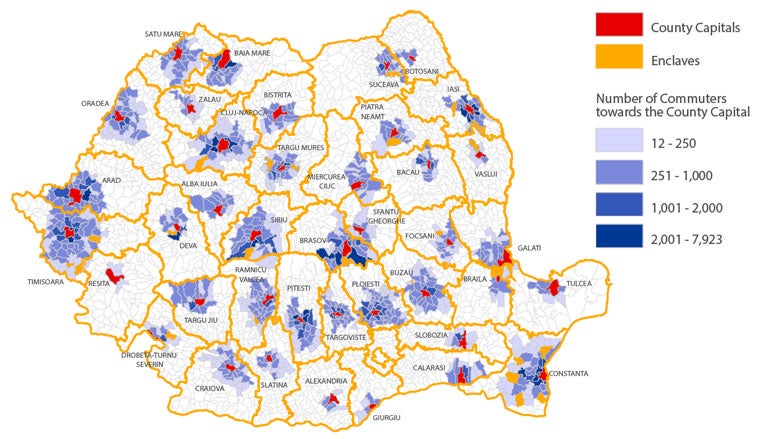Metropolitan development is important for Romania’s growth. An
analysis prepared by the World Bank for the Romanian Ministry of Regional Development and Public Administration (MRDPA) indicates that Romania’s eight largest metropolitan areas
[1] (Bucharest, Brașov, Cluj-Napoca, Constanța, Craiova, Iași, Ploiești and Timișoara) concentrate 50 percent of Romania’s population and generate 75 percent of firm revenues in the country.
Large metropolitan areas are critical for any economy. A report prepared by EuroStat shows that metropolitan areas in the EU generate around 70 percent of GDP, they register the fastest population growth rates, they generate a significant share of new jobs, and they concentrate a significant share of people with tertiary education.
Metropolitan areas are the economic engines of a country, and if these engines do not work well, neither does the economy as a whole. Unfortunately, in Romania, these engines do not function properly, as highlighted in another World Bank analysis prepared for MRDPA. There are only a few cities that have a functional metropolitan public transport system (e.g. Alba Iulia, Cluj-Napoca), few cities that have prepared spatial plans for the metropolitan area (e.g. Brăila, Brașov, Craiova), and even fewer that have managed to implement projects at the metropolitan level (e.g. Constanța).
What are some of the challenges facing metropolitan areas in Romania?

First, lack of adequate planning when it comes to metropolitan development. This can hinder dynamic growth and economic development. The stretch of road that connects the city of Cluj-Napoca to the suburb of Florești is the busiest stretch of road in Romania. It is also the road with the highest incidence of traffic accidents. Because there has been no metropolitan planning in Cluj, and because Florești does not have the resources to develop additional access routes to Cluj, rush hour traffic delays commutes by up to one hour, meaning more time in traffic and more air pollution.
Second, lack of a clear legislative framework and limited incentives from the central government, such as grants targeting metropolitan projects, limit the ability of local administrations to adopt an integrated approach to metropolitan development. Constanța is one of the Romanian cities facing a dire need for improved metropolitan planning and development, and one of the cities that has made important strides in this direction. However, according to Constanta Metropolitan Zone representatives, in the absence of incentives for projects from central government, mayors often prefer to focus solely on issues that directly affect their locality. This inevitably leads to a series of urban problems like traffic congestion and pollution, unsustainable spatial development patterns, and uncoordinated public investments.
Third, economic growth and investments in dynamic urban areas have put more and more people on the move, requiring integrated metropolitan transport solutions. The map above highlights the centrality of metropolitan development in Romania’s medium and large urban areas. The areas in red represent county capitals and the areas in blue the localities where at least 15 percent of the labor force commutes for work to a county capital. Virtually all county capitals attract labor from surrounding areas, and some cities (Constanța, Cluj-Napoca, Timișoara, Brașov, Ploiești, Sibiu, Oradea and Arad) attract workforce from further distances.
For example, the Municipality of Constanța attracts labor from the entire county. Every morning Constanța’s workforce grows by 26.4 percent, or around 38,000 people. A more developed city of Constanta generates important economic spillover effects for the entire county. Such is the case with other cities. If metropolitan areas grow, surrounding communities grow and have access to improved opportunities.

Urban specialists know that putting in place a good plan for an efficient and sustainable development of a city leaves no space for corrections down the road. Once a building has been constructed and a road has been laid, it is almost impossible to move them. When metropolitan areas do not develop as contiguous areas, but as individual localities and self-contained systems, there is a real risk of dysfunctional and inefficient urban growth.
Enhanced spatial planning is critical to attracting investors and supporting improvements in development outcomes at the urban level. This World Bank report can serve to inform the right policy options across many cities in Romania. More sustainable and more prosperous cities are central to Romania’s sustainable growth, and public authorities should play a key role in making these places thrive.
Large metropolitan areas are critical for any economy. A report prepared by EuroStat shows that metropolitan areas in the EU generate around 70 percent of GDP, they register the fastest population growth rates, they generate a significant share of new jobs, and they concentrate a significant share of people with tertiary education.
Metropolitan areas are the economic engines of a country, and if these engines do not work well, neither does the economy as a whole. Unfortunately, in Romania, these engines do not function properly, as highlighted in another World Bank analysis prepared for MRDPA. There are only a few cities that have a functional metropolitan public transport system (e.g. Alba Iulia, Cluj-Napoca), few cities that have prepared spatial plans for the metropolitan area (e.g. Brăila, Brașov, Craiova), and even fewer that have managed to implement projects at the metropolitan level (e.g. Constanța).
What are some of the challenges facing metropolitan areas in Romania?

First, lack of adequate planning when it comes to metropolitan development. This can hinder dynamic growth and economic development. The stretch of road that connects the city of Cluj-Napoca to the suburb of Florești is the busiest stretch of road in Romania. It is also the road with the highest incidence of traffic accidents. Because there has been no metropolitan planning in Cluj, and because Florești does not have the resources to develop additional access routes to Cluj, rush hour traffic delays commutes by up to one hour, meaning more time in traffic and more air pollution.
Second, lack of a clear legislative framework and limited incentives from the central government, such as grants targeting metropolitan projects, limit the ability of local administrations to adopt an integrated approach to metropolitan development. Constanța is one of the Romanian cities facing a dire need for improved metropolitan planning and development, and one of the cities that has made important strides in this direction. However, according to Constanta Metropolitan Zone representatives, in the absence of incentives for projects from central government, mayors often prefer to focus solely on issues that directly affect their locality. This inevitably leads to a series of urban problems like traffic congestion and pollution, unsustainable spatial development patterns, and uncoordinated public investments.
Third, economic growth and investments in dynamic urban areas have put more and more people on the move, requiring integrated metropolitan transport solutions. The map above highlights the centrality of metropolitan development in Romania’s medium and large urban areas. The areas in red represent county capitals and the areas in blue the localities where at least 15 percent of the labor force commutes for work to a county capital. Virtually all county capitals attract labor from surrounding areas, and some cities (Constanța, Cluj-Napoca, Timișoara, Brașov, Ploiești, Sibiu, Oradea and Arad) attract workforce from further distances.
For example, the Municipality of Constanța attracts labor from the entire county. Every morning Constanța’s workforce grows by 26.4 percent, or around 38,000 people. A more developed city of Constanta generates important economic spillover effects for the entire county. Such is the case with other cities. If metropolitan areas grow, surrounding communities grow and have access to improved opportunities.

Urban specialists know that putting in place a good plan for an efficient and sustainable development of a city leaves no space for corrections down the road. Once a building has been constructed and a road has been laid, it is almost impossible to move them. When metropolitan areas do not develop as contiguous areas, but as individual localities and self-contained systems, there is a real risk of dysfunctional and inefficient urban growth.
Enhanced spatial planning is critical to attracting investors and supporting improvements in development outcomes at the urban level. This World Bank report can serve to inform the right policy options across many cities in Romania. More sustainable and more prosperous cities are central to Romania’s sustainable growth, and public authorities should play a key role in making these places thrive.
[1] Defined as the areas comprising the city and the one hour access area (by car) from the boundary of the city


Join the Conversation